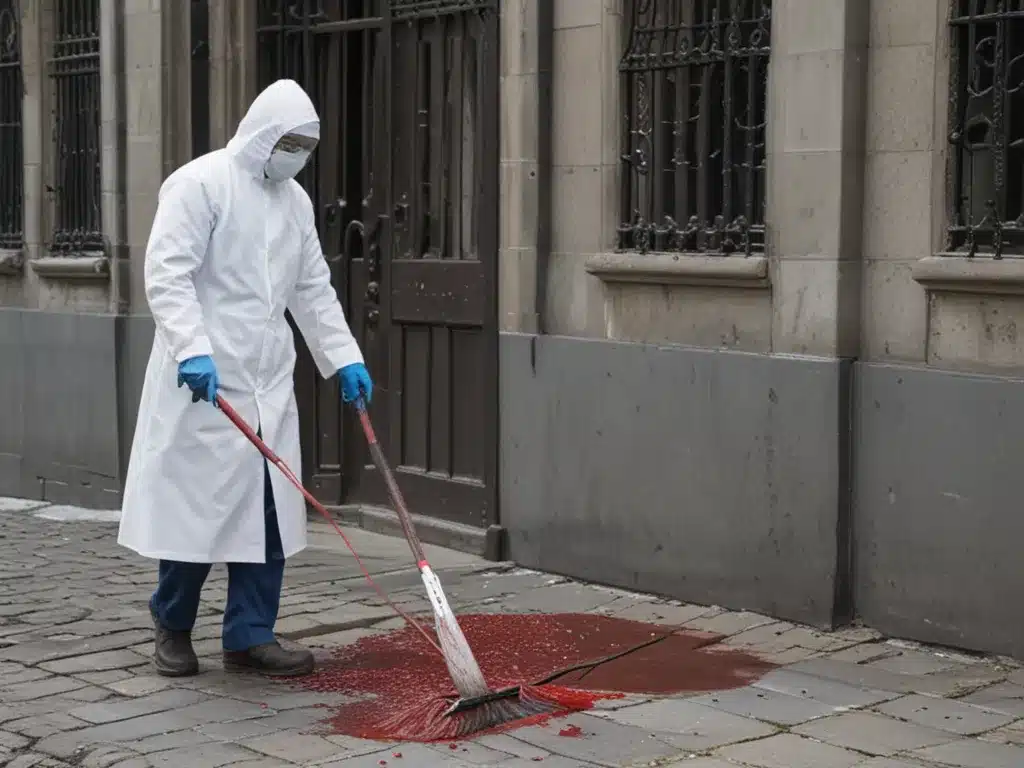Introduction
Bloodborne pathogens like HIV, hepatitis B, and hepatitis C viruses can live for days outside the body in blood and other bodily fluids. As a professional involved in bloodborne pathogen cleanup, it is critically important to understand how to properly clean up potentially infectious materials to prevent disease transmission and protect yourself and others.
I will cover key issues related to bloodborne pathogen risks and strategies to reduce transmission during the cleanup process. Proper training, protective equipment, disinfectants, disposal, and documentation procedures are essential for effective cleanup of blood and OPIM (other potentially infectious materials). Adhering to OSHA’s Bloodborne Pathogens Standard and other applicable regulations is also crucial.
Understanding Key Bloodborne Pathogen Risks
When cleaning up blood or OPIM, it is vital to remember that pathogens like HIV, hepatitis B, and hepatitis C can be transmitted through contact. Here are some key risks to keep in mind:
-
Contact with non-intact skin – Cuts, scrapes, and other breaks in the skin increase infection risk if exposed to contaminated blood or fluids.
-
Mucous membrane contact – Eyes, nose, and mouth are portals for bloodborne pathogen transmission. Avoid splashes.
-
Sharp object injuries – Needles, broken glass, etc. can pierce the skin and lead to infection. Handle with great care.
-
Aerosolization – Power washing or scrubbing spilled blood can cause infectious aerosol droplets. Minimize high-pressure cleaning.
-
Contaminated PPE – Gloves, clothing, masks and other PPE must be properly removed, disinfected and/or disposed of to avoid contact or cross-contamination.
Understanding how exposure can occur will help me take precautions and use best practices to minimize risks. My safety and that of others depends on it.
Personal Protective Equipment (PPE)
Using the appropriate personal protective equipment (PPE) is critical for any bloodborne pathogen cleanup. Key PPE includes:
-
Gloves – Impervious gloves like nitrile should be worn to avoid blood contact with skin. Double gloving provides an extra layer of protection.
-
Face and eye protection – Goggles, face shields and masks protect mucous membranes from splashes or sprays.
-
Fluid-resistant coveralls – Full-body coveralls create a protective outer barrier to keep blood off regular clothing and skin.
-
Shoe covers – Disposable shoe covers prevent blood contact with footwear. Waterproof boots may also be worn.
-
Head/hair covers – Hair nets or caps keep hair contained.
Proper donning, doffing and disposal of PPE is key. Care must be taken to avoid contact with contaminated outer-surfaces during removal. PPE should be treated as infectious waste.
Using Effective Disinfectants
EPA-registered disinfectants effective against HIV, hepatitis B and hepatitis C are vital for decontaminating surfaces and tools during and after blood cleanup.
-
Bleach solutions diluted to 1 part bleach + 9 parts water are inexpensive and highly effective disinfectants against bloodborne pathogens when used properly.
-
Other disinfectants like quaternary ammonium compounds may also be used per label instructions if effective against HIV and hepatitis viruses.
-
Contact time – Surfaces should be kept wet with disinfectant for the full contact time listed on the product label – often at least 10 minutes.
-
Rinsing and drying surfaces after the contact time ensures disinfection and removes chemical residues.
I will only use disinfectants approved for occupational use against bloodborne pathogens and follow all label directions carefully.
Disposal and Biohazard Waste Management
Proper disposal and waste management procedures help ensure removed materials do not transmit infection. Key guidelines include:
-
Sharps disposal – Needles, razors and other sharps will be placed into approved sharps containers capable of safely housing used sharps per OSHA guidelines.
-
Red bag waste – Heavily soiled materials will be double-bagged in approved red biohazard bags clearly marked with the biohazard symbol.
-
Treatment and transport – Biohazardous waste will be treated on-site via encapsulation or taken to an approved medical waste facility by a licensed transporter, adhering to DOT regulations.
-
Minimizing aerosols – Waste will be carefully poured/transferred into collection bags/containers in a manner that avoids splashes or aerosolization.
Proper PPE and safe handling techniques will be used when managing waste materials to protect myself and avoid transmission risks.
Documentation and Reporting Procedures
Documenting cleanup procedures, disinfectants used, exposed individuals and any incidents is important to support proper follow-up if needed. Key documentation practices include:
-
Recording dates, times, locations and procedures used during cleanup of blood or OPIM.
-
Identifying any workers potentially exposed to bloodborne pathogens during the response.
-
Fully reporting sharps injuries, mucous membrane exposures or any possible transmissions to supervisors and following proper post-exposure procedures.
-
Maintaining training records, Material Safety Data Sheets (MSDS) for disinfectants and other documentation required by OSHA.
Thorough documentation helps ensure exposures and incidents are properly managed for the health and safety of all workers involved.
Compliance with OSHA’s Bloodborne Pathogens Standard
The Occupational Safety and Health Administration (OSHA) Bloodborne Pathogens Standard 29 CFR 1910.1030 establishes crucial worker protections when handling bloodborne pathogen risks. Key elements I will comply with include:
-
Using Universal Precautions and personal protective equipment to prevent exposure.
-
Having an Exposure Control Plan detailing how my organization manages bloodborne pathogens.
-
Providing accredited training on bloodborne pathogen risks and exposure prevention.
-
Making hepatitis B vaccinations available to exposed workers.
-
Having procedures for post-exposure evaluation and follow-up if an exposure occurs.
Strict adherence to OSHA’s Bloodborne Pathogens Standard is vital for protecting myself and others when cleaning up potentially infectious materials.
Conclusion
Preventing the transmission of bloodborne pathogens like HIV, hepatitis B and hepatitis C requires diligent use of protective equipment, proper disinfectant procedures, safe disposal of contaminated items, thorough documentation, and compliance with OSHA standards. By understanding and reducing exposure risks, I can perform cleanups safely. Consistent use of Universal Precautions is key to reducing health hazards for myself and any other exposed individuals. With proper precautions and training, bloodborne pathogens can be effectively controlled.







